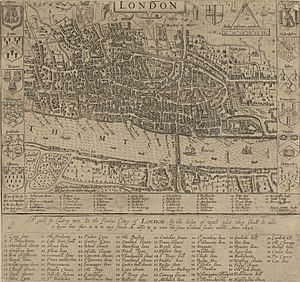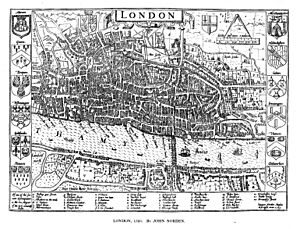John Norden facts for kids
John Norden (born around 1547, died 1625) was an English expert in maps and local history. He was known for planning a huge project to map and write the history of every county in England. This big work was called the Speculum Britanniae. Besides his mapmaking, he also wrote many religious books.
Contents
John Norden's Life Story
John Norden was born in Somerset, England, into a well-respected family. We don't know much more about his early life. He started studying at Hart Hall, Oxford, in 1564. He earned his first degree in 1568 and a master's degree in 1573.
After university, Norden moved around a lot. For most of his life, he lived near London in Middlesex. He lived in Walham Green in 1592. By 1607, he was in Hendon, where he stayed until 1619. Later, he moved to St Giles in the Fields and passed away there in 1625. John Norden was married and had at least two sons, John Jr. and Josias.
His Work: Maps and County Histories
John Norden was a cartographer (mapmaker) and a chorographer. A chorographer describes regions or countries, including their geography, history, and people.
His Big Map Project: Speculum Britanniae
Norden's most famous project was the Speculum Britanniae. This Latin name means "Mirror of Britain." He wanted to create maps and history books for all of England's counties.
The first part of this project came out in 1593. It was called Speculum Britanniae: the First Parte: an Historicall, & Chorographicall Discription of Middlesex. This book described the county of Middlesex.
In 1596, he published a "Preparative" book for his project. In 1598, another part of his main work was printed. This one was called Speculi Britaniae Pars: the Description of Hartfordshire, focusing on Hertfordshire.
Norden also finished detailed descriptions of five other counties in handwritten form. Three of these were printed many years after he died. These included Essex (published 1840), Northamptonshire (published 1720), and Cornwall (published 1728). Sadly, his writings for Kent and Surrey are now lost.
Later Surveying Work
John Norden also worked as a surveyor for the English Crown. In 1600, he became the surveyor of royal woods and forests in several counties. These included Berkshire, Devon, and Surrey.
In 1605, he became the surveyor for the Duchy of Cornwall. In 1607, he created a valuable description of the Honor of Windsor. This work included beautiful colored maps and plans. He dedicated it to King James I.
In 1612, he was made surveyor of royal castles in many southern counties. These included Kent, Surrey, Sussex, and Cornwall. His last known works were a survey of Sheriff Hutton manor in Yorkshire in 1624. He also worked on a guide for English travelers in 1625, just before he died.
Norden's Important Maps
Norden's maps of London and Westminster from 1593 are very important. They show us what these cities looked like during the time of the Tudor kings and queens.
He also made notable maps of Middlesex (1593), Essex (1594), Hertfordshire (1598), and Cornwall (published 1728). His Cornwall map was special because it was the first English map to show roads!
Norden also created maps for other famous works. He made maps for the 1607 edition of Camden's Britannia. He also made maps for John Speed in 1610.
Some of Norden's important maps are now lost. These include a large map of battles fought in England. Also lost are an eight-sheet "View of London" from around 1604-1606 and a "View of London Bridge" from 1624.
Religious Writings
It was often hard for John Norden to find people to support his mapmaking. So, he found a more steady way to earn money: writing religious books. He published twenty-four of these books between 1582 and his death.
One of his most popular religious books was A Pensive Mans Practise. It was first published in 1584. This book was so popular that it had over forty editions printed during his lifetime!
Norden always kept his mapmaking and religious writing separate. At one point, he faced political trouble because he dedicated some religious books to the Earl of Essex. He tried to say that another person with his name wrote the religious books. However, historians have since confirmed that it was indeed the same John Norden who wrote both.




